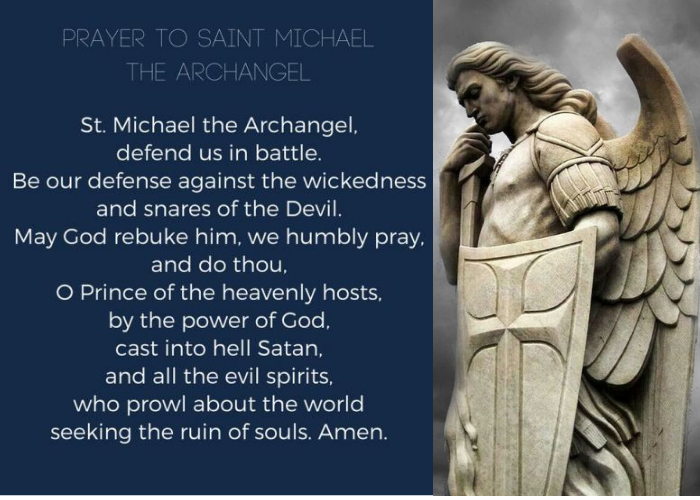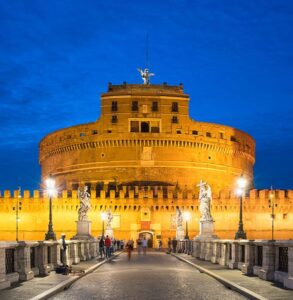
MICHAEL IN SCRIPTURE
St. Michael the Archangel is universally regarded as one of God’s most powerful angels against all that is evil. Michael, an angel, and thus a pure spirit, is the only angel mentioned by name four times in Holy Scripture. Most significant are his appearances in the twelfth chapter of Daniel, where we read, “At that time there shall arise Michael, the great prince, guardian of Your people; It shall be a time unsurpassed in distress since the nation began until that time. At that time Your people shall escape, everyone who is found written in the book.” In the Book of Revelation, twelfth chapter, we read, “Then war broke out in heaven; Michael and his angels battled against the dragon. The dragon and its angels fought back, but they did not prevail and there was no longer any place for them in heaven. The huge dragon, the ancient serpent, who is called the Devil and Satan, who deceived the whole world, was thrown down to earth, and its angels were thrown down with it.” Michael also appears numerous times in non-canonical apocryphal books.
FOUR OFFICES
Michael is actually believed by the Catholic Church to have four offices or roles: to lead God’s heavenly forces against Satan and his minions; to deliver the souls of the deceased to judgment; to be the protector and guardian of God’s chosen people – Jews in the Old Testament and Christians in the New Testament; and to protect souls at the time of their death from Satan’s power. It is not known which of the choirs of angels Michael belongs to. Sts. Basil the Great and Robert Bellarmine believed him to be the prince of all the angel choirs. St. Bonaventure believed him to be the head of the choir of Seraphim. St. Thomas Aquinas believed him to be the head of the lowest choir, the angels. In the early centuries of the Church, Michael was mostly viewed as a healer. He was believed to have brought forth curative springs during the first century near Colossae which prompted many healings.
APPEARANCES AND APPARITIONS

A plague in Rome passed after Michael was invoked by the prayers of Pope [St.] Gregory the Great. Michael appeared bearing a great sword over the mausoleum of the Emperor Hadrian. The sick, to obtain his protection, slept there at night. After this apparition, the building became known as Castel Sant’Angelo. Michael was reported to have appeared to a bishop in the eighth century on a rocky island just off the coast of Normandy, France, now known as Mont-Saint-Michel. A grand Benedictine monastery was built after this apparition and the abbey church still stands atop the rocky cliff.
One of Michael’s most interesting apparitions was to the young [St.] Joan of Arc, the fifteenth century mystic and war heroine. He first manifested to her when she was thirteen as a voice accompanied by bright light, identifying himself by name and kindly encouraging her to be holy. He later appeared to her numerous times in bodily form, “attended by heavenly angels” and protecting her from harm. He consistently was kind and fatherly, but resolute in guiding her along the path of holiness. At some point, he informed Joan of the mission God had chosen her for. When she protested, citing her inadequacy, he reassured her that if she only relied on God, she could accomplish her mission. He predicted many things that actually came true. The personal information he disclosed to her about the reluctant king, Charles VII, prompted Charles to grant her the thousands of troops she needed, stating that no human being could have known this information. Michael guided Joan through successful battles, to the astonishment of the men who knew that she had no military experience. He also braced her for the ordeals she would have to face toward the end of her life. An eighteenth century Carmelite nun from Portugal received a private revelation from Michael requesting a devotion known as the Chaplet of St. Michael. This devotion honors and entreats the nine choirs of angels, and the devotion was approved by Pope Pius IX in 1851.

QUIS UT DEUS!
St. Michael is usually depicted in a human form, in full battle array, and bearing a shield stating Quis ut Deus, meaning “Who is like God!”. This is believed to have been his battle cry when the rebellious angels were cast out of heaven for their jealousy and defiance. Because he is an angel, not a human, he never went through a canonization process as humans do now. He has been daily invoked for protection against evil since the late nineteenth century. St. Michael has many patronages, including mariners, police officers, paramedics and the military. He is also a particular patron for United States Army paratroopers, especially the famed 82nd Airborne Division. St. Michael’s feast day has been September 29 since the sixth century and was long known as Michaelmas Day and was once a Holy Day. He is now joined with the other two named angels of Scripture, Gabriel and Rafael who share the feast day of September 29.
